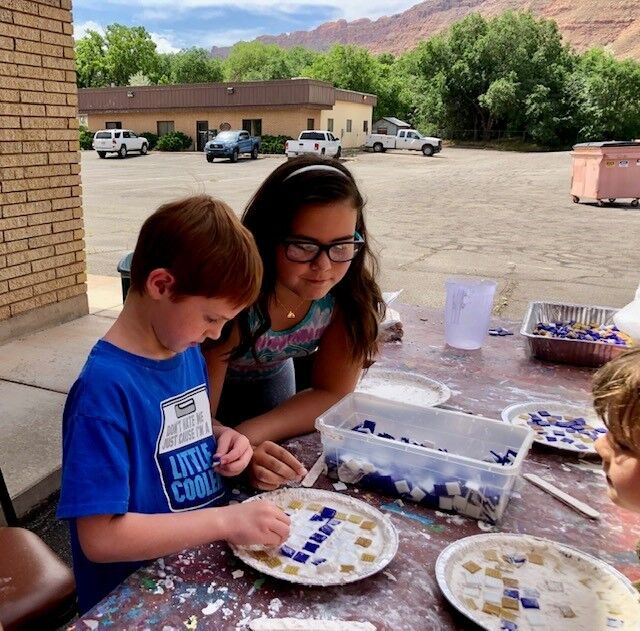Some information may be outdated.
“If somebody has something that they’re interested in, whether it’s rockets, robotics, cooking, crafts, sewing, animals, photography—whatever they’re interested in, we can start a club,” said Catherine Hansen, program coordinator for Grand County’s 4-H program.
4-H is a nation-wide youth development organization created in the early 1900s and delivered by universities and county offices. Utah State University’s Moab Extension provides coordination and leadership for the local 4-H group, and offers programs, led by volunteers, for youth from kindergarten through twelfth grade.
Some of those clubs reflect the agricultural roots of the organization, such as a horse club and a small animal club. However, 4-H clubs can focus on anything that builds skills and confidence in youth. This fall, for example, USU departments offered online lessons for sixth through twelfth graders on topics such as Outdoor Product Design & Development, Aviation, and Small Business Development.
Moab area local Debbie Lovato Thurman got involved with 4-H when her daughter, Kailee Thurman, joined 4-H’s Cloverbud Club, an activity group for kids from kindergarten to third grade. Kailee, now 13, has outgrown the Cloverbuds, but she continues to participate in 4-H. Debbie Thurman now volunteers as a group leader both for the Cloverbuds and for a group called Summer Splash, which included swimming, arts and crafts, and self-esteem building activities in the summer of 2019.
Kailee joined the Summer Splash group and also helps her mom lead the Cloverbuds in activities like rock painting, making finger puppets, scrapbooking, and nature walks. Kailee also participates in cooking, dance, and tennis clubs.
This past summer, the pandemic meant that clubs weren’t meeting in-person, but Kailee stayed involved by taking advantage of activity kits put together by 4-H coordinators. Kits were distributed from the USU Extension campus and also from Grand County Library.
“She’s done sewing for several years and she loves sewing,” said Debbie Thurman. “That’s one of the kits they put together.” One of the take-home projects was sewing a face mask.
Hansen said that in addition to activity kits, 4-H created videos with lessons and how-to instructions for crafts and posted them to the USU Extension Facebook page. She expects such videos will continue even after the pandemic has subsided.
“Even after COVID restrictions are lifted, we feel like virtual is here to stay,” she said. But she’s looking forward to when gathering is safe again.
“I am trying to expand it to be year-round and include a few more things,” she said of the local 4-H program, noting that it has in the past been active mostly in the summer and served mostly elementary school-aged kids. “I’m definitely interested in expanding it for a broader range of ages as well.”
Hansen is eager for suggestions from local youth on what new programs 4-H should offer.
“I really want to focus on the interest of the kids,” she said. She listed some more potential themes: finance, exercise for health, geology, interior design, foreign languages—“Essentially anything,” she said.
Hansen also noted there is value in offering options other than those that kids specifically request—the opportunity for kids to discover a new hobby or pursuit.
“There may be something that we can provide, something they didn’t know they were interested in,” Hansen said. She’s excited to design a program around three “underwater vehicles” equipped with cameras that USU Moab acquired last year from a Salt Lake City 4-H club that had extras. She foresees the technology will be an exciting avenue to study aquatic ecology and water quality.
Hansen noted that 4-H is very affordable—just $10 a year for participation in up to three clubs. Some clubs may have other associated expenses, but scholarships are available. She also tipped high schoolers preparing for college that 4-H is a great place to gain leadership experience.
Debbie Thurman agreed the program is a great opportunity for kids and for parents.
“It’s a wonderful resource,” she said. “I think more parents could become involved—a lot of parents have wonderful resources they could share, whether its cooking or crafts… if they’re knowledgeable in pottery or leather skills, they can share that with kids.” She added that participation is inexpensive and encourages kids to engage in enriching activities.
“It’s a good way for kids to get off their electronics and stay out of trouble,” she said.
To learn more, contact Catherine Hansen at 435-259-7558 or catherine.hansen@usu.edu, visit the USU Moab Extension Facebook page, or go to 4h.zsuite.org.
Appreciate the coverage? Help keep local news alive.
Chip in to support the Moab Sun News.





